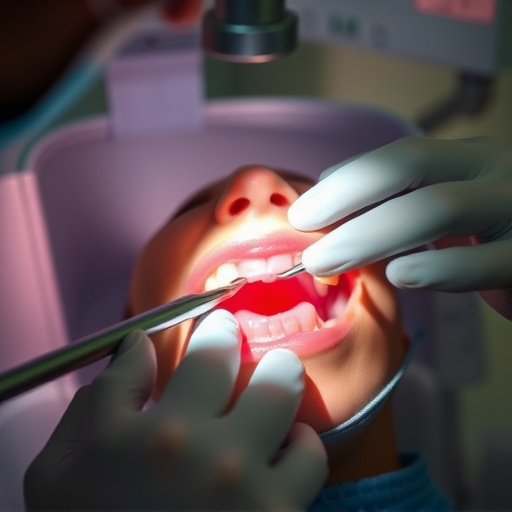Root Canal Treatment (RCT) saves severely damaged or infected teeth by removing and cleaning the inner part, preserving natural structure and alleviating pain. Post-procedure, a crown restores function and appearance, ensuring tooth strength against normal chewing forces. Early detection through regular dental check-ups is crucial; fillings alone can't save pulpal infections. Proper aftercare, including adhering to instructions, rigorous hygiene, and regular check-ups, ensures RCT success, preventing infections and fostering healing.
“Root canal treatment is a highly effective procedure that can save your natural smile, alleviating tooth pain and restoring oral health. This article delves into the intricacies of root canal treatment, guiding you through the procedure, its benefits, and who needs it most. We’ll explore how to recognize the signs of dental issues requiring this intervention and provide essential aftercare tips for long-term smile vitality. Understanding root canal treatment is crucial in maintaining a healthy, vibrant oral ecosystem.”
- Understanding Root Canal Treatment: The Procedure and Its Benefits
- Who Needs a Root Canal? Recognizing the Signs and Seeking Timely Intervention
- Aftercare and Long-term Health: Ensuring Your Smile Thrives Post-Treatment
Understanding Root Canal Treatment: The Procedure and Its Benefits

Root Canal Treatment (RCT) is a specialized dental procedure designed to save a severely damaged or infected tooth. It involves removing the pulp and nerve tissue from the inner part of a tooth, known as the root canal, and then cleaning, shaping, and filling it with a material that supports and protects the remaining tooth structure. This treatment is often recommended when a tooth’s pulp becomes inflamed or infected due to decay, cracks, or trauma.
One of the key benefits of RCT is its ability to preserve the natural tooth, avoiding the need for extraction. By removing the infected pulp, it prevents further spread of infection and pain. After the procedure, a crown is typically placed over the treated tooth to restore its function and appearance, ensuring it can withstand normal chewing forces just like any other tooth, even if it’s been through a challenging situation, such as wisdom tooth removal or other dental issues that require general dentistry intervention. This not only enhances aesthetics but also strengthens the tooth, making it a viable long-term solution in place of more invasive procedures like dental bonding.
Who Needs a Root Canal? Recognizing the Signs and Seeking Timely Intervention

Many people wonder when they might need a root canal treatment. The truth is, it’s not always obvious. However, recognizing certain signs can help you identify when your natural smile might be in need of this crucial dental procedure. One of the primary indicators is severe tooth pain that doesn’t subside with simple measures like over-the-counter painkillers. This pain could radiate to your jaw or even your neck and shoulders. Swelling, tenderness, or pimples around the affected tooth are also red flags. Moreover, if you notice a persistent bad breath or a foul taste in your mouth that isn’t connected to poor oral hygiene practices, it could be an indication of an infected root canal.
Seeking timely intervention is vital. Ignoring these signs might lead to more complex dental issues. Regular dental cleanings and check-ups play a pivotal role in maintaining oral health, enabling early detection of problems like tooth decay or infections. While dental fillings can often repair damaged teeth, when the damage reaches the inner layers of the tooth, including the pulp, a root canal becomes necessary for tooth repair and to prevent further complications.
Aftercare and Long-term Health: Ensuring Your Smile Thrives Post-Treatment

After a root canal treatment, proper aftercare is essential to ensure your smile thrives long-term. It’s crucial to follow your dentist’s instructions meticulously, including any prescribed medications and recommendations for rest. Maintaining excellent oral hygiene becomes even more vital post-treatment; regular brushing, flossing, and dental cleanings are non-negotiable. These measures help prevent infection, promote healing, and safeguard your restored tooth.
Additionally, scheduling routine oral exams is paramount to monitor the health of your smile over time. Comprehensive dental care involves addressing any potential issues early on, preventing complications, and ensuring longevity in your treated tooth. Remember, proper aftercare is a partnership between you and your dentist, working together to preserve your natural smile for years to come.
Root canal treatment is a highly effective solution for saving natural smiles, alleviating pain, and restoring oral health. By understanding the procedure, recognizing when it’s needed, and following proper aftercare, individuals can enjoy long-term benefits and maintain a vibrant smile. This conservative approach allows patients to avoid tooth extraction and preserve the natural structure of their dentition. Embrace root canal treatment as a game-changer for your oral health, ensuring you receive prompt intervention when signs arise.














